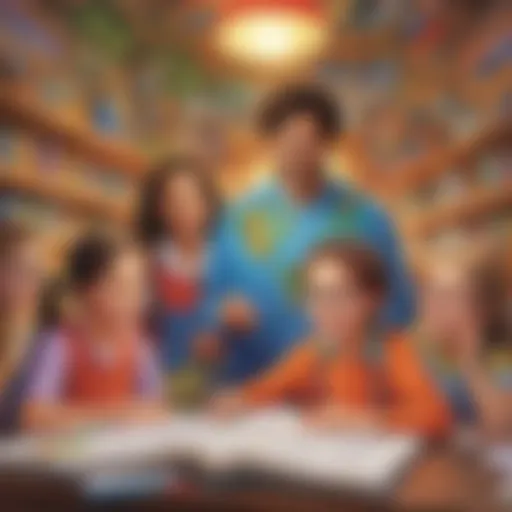Creative Thank You Note Ideas for Teachers
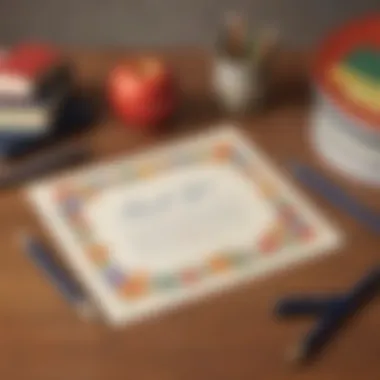

Intro
Teachers play a crucial role in shaping the minds of young individuals. They invest time and effort into nurturing students, making the expression of gratitude essential. Expressing thanks through thoughtful notes can foster a deeper connection between students and teachers. When students convey appreciation, it strengthens the educational environment and makes learning more impactful.
This article will explore various ways to create meaningful thank you notes for teachers. We will discuss personalized messages, thematic notes, and even group efforts that can enhance how students express their gratitude. By understanding and applying these ideas, students can reflect on the importance of appreciation in education.
Creative Activities
Craft Ideas
Creating thank you notes doesn’t have to be a simple task. Engaging in creative activities can make the process more enjoyable. Simple crafts can leave a lasting impression.
- Handmade Cards: Students can design cards using colored paper, markers, or stickers. A personal touch sets these cards apart.
- Art Collages: Gather drawings or photos from the class to assemble a collage. Each student can contribute a piece of artwork to show collective appreciation.
- Bookmark Gifts: Students can create bookmarks with a thank you message. Something practical yet heartfelt helps reinforce gratitude.
Step-by-Step Guides
Here are some easy steps for creating handmade cards:
- Choose Your Material: Select some colored paper, scissors, and any decorations.
- Fold the Paper: Fold the paper in half to create the card shape.
- Design the Front: Use markers or stickers to write a welcoming message or draw something special.
- Write a Note Inside: Personalize the message. Share what was learned or what made the teacher special.
- Sign It: Ensure every student signs the card.
Educational Value
Engaging in creative activities has benefits beyond just expressing gratitude. Such activities encourage creativity and teamwork. They also help develop fine motor skills, especially for younger children.
Personalized Messages
When writing thank you notes, the content matters. Personalized messages resonate better than generic ones.
- Be Specific: Mention specific lessons or support that were meaningful.
- Express how it helped: Explain how the teacher’s guidance made a difference.
- Use positive language: Keep the tone sincere and appreciative.
A direct approach conveys authenticity. Students should choose words that genuinely reflect their thoughts.
"A heartfelt message can create a memorable connection between students and teachers."
Thematic Notes
Creating themed thank you notes can add a creative flair to the message.
- Seasonal Themes: Align notes to holidays or seasons. For example, notes around Thanksgiving can emphasize gratitude.
- Subjects: Tie the message to the subject taught. A science-related thank you note can include fun facts.
This approach not only shows appreciation but also reflects the subject's influence on the student’s learning journey.
Collaborative Group Efforts
Encouraging students to work together on thank you notes can foster camaraderie. Group projects create a sense of unity and shared purpose.
- Class Thank You Board: Create a board where every student can add a note throughout the year. It serves as a constant reminder of gratitude.
- Group Messages: Have students collaborate to draft a collective note. Everyone can contribute their ideas before finalizing the message.
Synthesizing the Information
Engaging in creative activities, writing personalized messages, adopting thematic approaches, and collaborating as a group can make gratitude impactful. This effort reflects not just the effort of the teacher but also the value placed on the role they play in education. Acknowledging this connection is vital for fostering a positive educational atmosphere.
Understanding the Importance of Thank You Notes
Thank you notes serve a crucial role in education, fostering connections between students, parents, and teachers. They represent a tangible expression of gratitude. This simple act can have meaningful implications for the classroom environment. Acknowledging a teacher's efforts enhances the sense of belonging among students, encouraging a supportive learning atmosphere.
The Role of Gratitude in Education
Gratitude is more than a polite response; it is an essential component in building relationships. In an educational context, it contributes to a positive classroom dynamic. When students express thanks, they strengthen their rapport with teachers. This mutual appreciation can enhance communication and cooperation. Furthermore, gratitude helps in developing emotional intelligence. Students learn to recognize the efforts of others, enhancing their social skills.
Moreover, gratitude can influence teachers' feelings of job satisfaction. When educators receive appreciation, it reaffirms their commitment to their students' success. As a result, they are more likely to invest time and effort into their teaching. This cyclical effect creates a reinforcing loop of positivity, where appreciation leads to better engagement, creating a more productive learning environment.
Benefits of Expressing Appreciation to Teachers
Recognizing and expressing appreciation towards teachers carries several benefits:
- Enhances Teacher Motivation: A simple thank you note can uplift a teacher's spirits. It shows them that their work does not go unnoticed. This encouragement can lead to increased enthusiasm in their teaching practices.
- Builds Positive Relationships: Regular expressions of gratitude help to cultivate trust. This connection encourages open dialogue between students and teachers, making the learning experience more enriching.
- Promotes a Positive Learning Environment: When teachers feel appreciated, they are more likely to create an atmosphere of encouragement and support. This, in turn, motivates students to perform better academically and socially.
- Encourages Reflective Practices: Students reflecting on what they are thankful for can enhance their critical thinking. They articulate specific instances where a teacher made a difference, reinforcing their learning.
"Gratitude turns what we have into enough."
In summary, understanding the importance of thank you notes lies in their capacity to strengthen educational bonds. Acknowledging teachers reinforces their dedication and positively impacts students' educational experiences.
Types of Thank You Notes
The expression of gratitude towards teachers can take many forms. Understanding the different types of thank you notes is essential for making each message feel personal and meaningful. This section will explore various options for writing thank you notes, enabling students to customize their messages based on their feelings and experiences.
Personalized Thank You Notes
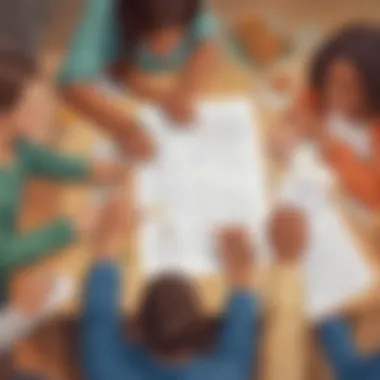
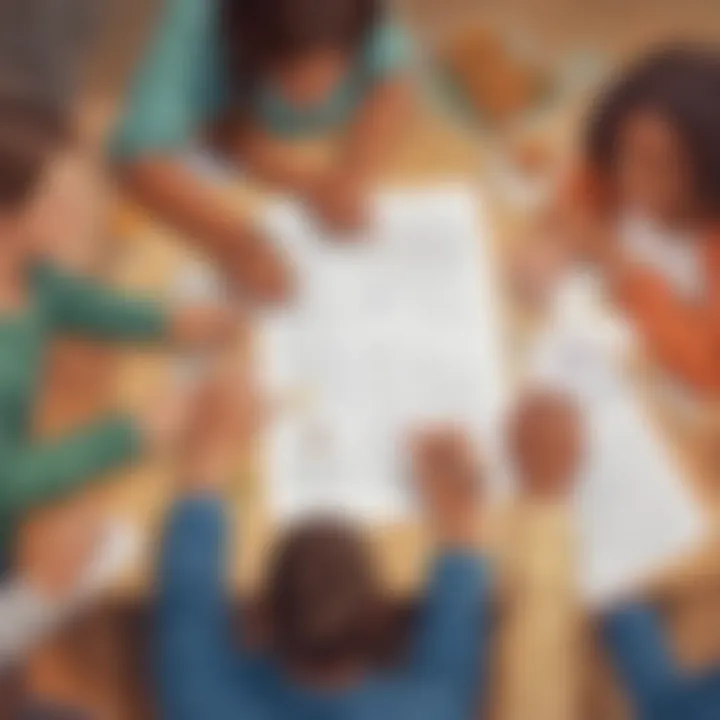
Personalized thank you notes stand out because they come directly from the sender’s heart. They offer a chance to express genuine feelings, making teachers feel appreciated and recognized.
Direct Messages
Direct messages are perhaps the simplest form of communication. They allow students to share their feelings clearly and concisely. This immediacy makes direct messages a popular choice for those who want to express gratitude quickly. A personalized direct message can include a simple "thank you for your patience" or something more specific, like "thank you for teaching me how to solve math problems."
The key characteristic of a direct message is its straightforwardness. It does not require decoration or embellishment; the sincerity speaks for itself. However, the drawback may be that these notes could come off as less thoughtful if not tailored enough. Being specific about a moment or action will enrich the message.
Specific Examples of Impact
Using specific examples of impact in thank you notes can deepen the appreciation expressed. When students mention particular instances, such as help in overcoming a difficult concept or encouragement in a challenging situation, it connects the message to real experiences. This reinforces the notion of gratitude.
The uniqueness of this approach lies in its ability to elucidate the impact teachers have on individual students. It makes the note more than just a customary message; it personalizes the appreciation. This specificity, however, can also be challenging for some students who may struggle to articulate their thoughts clearly. Nevertheless, this type of note resonates better, enhancing the recipient's positive feelings.
Group Thank You Notes
Group thank you notes provide an opportunity to express collective appreciation. They are beneficial for fostering camaraderie among students while acknowledging a teacher's efforts. This makes such notes a valuable choice in various educational settings, emphasizing unity.
Collaborative Efforts by Classmates
Collaborative efforts among classmates to create a thank you note foster teamwork. Each student can contribute a line or a sentence, turning the note into a patchwork of voices. This variety reflects the collective sentiment of gratitude.
This group effort also teaches students about collaboration and communication. The unique feature of a group note is that it shows a teacher they impacted many students, not just one. On the downside, coordinating contributions can lead to inconsistency in tone and message clarity if not managed well.
Collective Messages of Appreciation
Collective messages of appreciation encapsulate diverse experiences and feelings into a single note. This method highlights the global impact a teacher has on a classroom environment. By acknowledging the teacher's influence on collective successes, such messages resonate strongly.
The significance lies in the power of numbers; when many voices share similar sentiments, it amplifies the message. However, if the message becomes too generic, losing individual emotion, it may fail to make a strong impact. Therefore, balancing collective feelings with individual touches helps preserve the note's essence.
Thematic Thank You Notes
Thematic thank you notes bring added layers of creativity to expressing gratitude. These notes can follow specific themes, making them stand out and display thoughtfulness more effectively.
Seasonal Themes
Using seasonal themes can enhance the joy of expressing thanks. For instance, a note decorated with autumn colors or winter imagery can align with community and celebration periods. It can showcase care in crafting the message, showing the teacher that their efforts coincide with special times of the year.
One benefit of this approach is its easy relatability during holidays; it can evoke nostalgia and warmth. However, students must ensure their messages align with the theme chosen. If done mismatched, it can detract from the overall message.
Subject-Specific Themes
Subject-specific themes allow students to relate their messages to the teacher's expertise. For instance, a science-themed note can include drawings of planets while thanking the teacher for making complex topics clear. This method adds a personal touch that communicates appreciation through subject relevance.
The main advantage here is the connection it fosters between subject matter and gratitude. It enforces the idea that the teacher is more than just an educator; they are a crucial part of the students’ learning journey. A potential challenge lies in maintaining creativity without overwhelming the central message. Keeping it clear and focused is vital to ensure it's effective.
Crafting the Perfect Message
Crafting the perfect message is central to creating effective thank you notes for teachers. The message is not just a collection of words on a page. It serves as a vessel for gratitude and appreciation, reflecting the bonds formed between students and educators. Thoughtful messaging can elevate the note from a mere formality to a significant expression of respect and acknowledgment. Such messages do not only benefit the recipient but also enhance emotional intelligence and mindfulness in students. By carefully considering the content of their notes, students reinforce positive relationships and encourage a culture of gratitude.
Elements of a Thoughtful Note
Clarity and Closeness
Clarity and closeness refer to the ability to convey heartfelt feelings in a straightforward manner. This aspect enhances the readability and impact of the message. Without clarity, the notes can easily confuse recipients, diluting the appreciation intended. A clear message shows respect for the teacher’s time and effort in reading the note. Furthermore, closeness indicates how personal or relevant the message is. When a student refers explicitly to moments they shared with their teacher, it creates a feeling of intimacy. Not only does clarity make the sentiments understandable, but it also allows for deeper personal connections to flourish.
Having clear and close communication foster a genuine exchange of appreciation. This approach is beneficial as it ensures that the intention behind the note is unmistakable. However, one must avoid overly simplistic language that could undermine the sincerity of the message.
Authenticity of Tone
Authenticity of tone is the essence of conveying genuine gratitude. It involves using one's natural voice and expression while writing. A sincere and authentic tone adds depth to the message. When students use their unique voice, the notes resonate more profoundly with the teachers. Authenticity helps in building trust, strengthening the bond. Students who embrace their real feelings are more likley to touch the heart of their educators.
The benefit of an authentic tone is that it allows for honest expression. However, it is essential to find a balance. Being too casual or informal can lead to misunderstandings. Therefore, sticking to a tone that reflects respect while retaining personal warmth is crucial.
Finding the Right Words
Sample Phrases
Sample phrases offer essential linguistic frameworks that students can adopt. These can range from simple thank yous to elaborate expressions of gratitude. Such phrases can guide students in articulating their thoughts effectively. Phrases like "I appreciate your support on my project" or "Your enthusiasm made learning fun" offer concrete examples of appreciation. Using such samples encourages students to express specific moments and contributions rather than generic gratitude.
The strength of sample phrases lies in their ability to inspire. They provide a starting point to build upon. However, it is important for students to modify these phrases to ensure they remain personal and relevant, avoiding the pitfall of sounding formulaic.
Expressive Language Suggestions
Expressive language suggestions involve a wider array of vocabulary that can paint a vivid picture of appreciation. Students can consider synonyms or descriptive terms that can elevate the emotional weight of their notes. Instead of mere thanks, using words like "grateful" or "indebted" can add authenticity. Expressive language makes the sentiment richer and can evoke more powerful responses from recipients.
The benefit of using expressive language is increased engagement with the message. Crafting a note that feels heartfelt requires more than just using standard phrases. However, overcomplicating language can lead to confusion. Simplicity often resonates more than bombastic vocabulary.
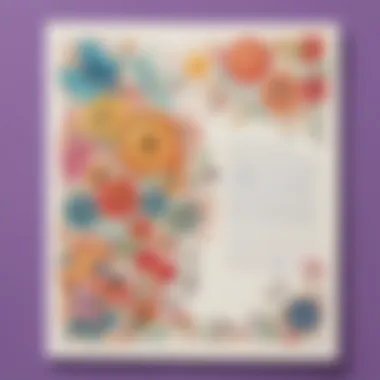
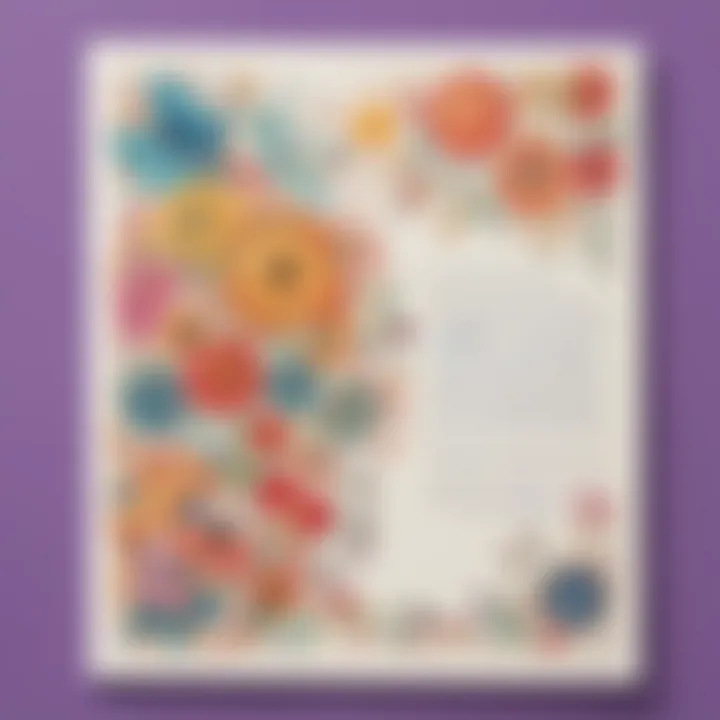
"Crafting messages with clarity and authenticity can profoundly affect how gratitude is received and remembered."
Creative Formats for Thank You Notes
Expressing gratitude through various formats adds depth to the communication. Creative formats for thank you notes can enhance the message and make it memorable. Selecting the right format allows the sentiment to shine and better conveys appreciation towards educators. Each format has unique qualities and can appeal to different audiences.
Handwritten Notes
Handwritten notes carry a personal touch. This format shows effort and dedication. The act of writing by hand connects the sender with the recipient. It can evoke strong emotions. A handwritten note might include anecdotes or a specific incident that illustrates the teacher's impact. The personalization in content resonates well. Families may choose stationery that reflects their child's personality or interests. This small detail can make the note feel even more special.
Digital Thank You Notes
Digital thank you notes have gained popularity due to their convenience. They can be easily shared and often reach teachers instantaneously. This format can take various forms, like e-cards or posts on social media. While the immediacy is a strong advantage, it lacks the tactile experience of a handwritten note.
E-cards
E-cards are versatile and customizable. They can be designed to suit the occasion or teacher's interests. A key characteristic is that they can be funny or heartfelt, depending on the message. E-cards often include animations or sounds that bring a playful element to the note. This format can also save paper, making it eco-friendly. However, some may argue that they lack the warmth of handwritten notes. The interaction is somewhat impersonal, which might lessen the intended emphasis on gratitude.
Social Media Posts
Social media posts allow for wider sharing of appreciation. They can feature images, videos, or even collective messages from the class. The key characteristic is the ability to engage a larger community. This not only acknowledges the teacher but can also inspire others to express gratitude. The downside is that not all teachers are active on social media, which may limit the impact of this format. Furthermore, public displays of appreciation could make some teachers feel uncomfortable.
Incorporating Student-Created Elements
Incorporating student-created elements into thank you notes adds a personal touch that is often deeply appreciated by teachers. When students express their gratitude through their own creations, it fosters a sense of ownership and creativity. This method not only allows students to engage personally with their educators but also enhances their artistic and expressive skills. Moreover, these unique contributions can reveal the strengths and feelings of the students, leading to a more genuine expression of appreciation.
Art Projects as Thank You Notes
Drawings and Paintings
Drawings and paintings hold a special place in the realm of thank you notes for teachers. The act of creating visual art can be therapeutic and meaningful for students. Such projects allow students to convey their feelings visually, which can sometimes express emotions better than words. A bright and colorful drawing can easily brighten a teacher's day, serving as a reminder of the joy and growth that happens in the classroom.
One key characteristic of drawings and paintings is their ability to be personalized. Each student's work is unique and reflective of their personality and experiences in the classroom. Additionally, these creations can be displayed in the classroom or teachers’ lounges, often becoming cherished decor that reminds educators of their positive impact.
However, while drawings and paintings are generally beloved, they do have some disadvantages. For instance, not all students may feel confident in their artistic abilities, which could limit participation. Ensuring that all students have the opportunity to contribute meaningfully can sometimes be a challenge.
Craft Integrations
Craft integrations offer an alternative method for students to express gratitude through more hands-on approaches. Projects involving crafts can include elements like creating collages, scrapbook pages, or even 3D models. This medium allows students to utilize various materials, fostering creativity while working collaboratively.
The hands-on nature of crafting encourages teamwork and collaboration among students, making it a fun group activity. By working together on a collective project, students can strengthen their bonds while creating something special for their teacher.
Yet, craft integrations may require additional resources and time, which can be a downside in a busy school environment. Finding adequate materials and managing classroom time effectively can present challenges. Assuming teachers are willing to allocate resources, however, the benefits of creativity and collaboration outweigh these potential hurdles.
Creative Writing Contributions
Poetry
Poetry as a form of thank you note is a splendid way for students to articulate their feelings in a thoughtful manner. Poems can capture emotions, memories, and gratitude more succinctly than prose, often leading to deeper reflections. The rhythmic and often melodic nature of poetry allows for a unique expression that can astound and resonate with both the writer and the reader.
A key characteristic of poetry is its versatility; it can be written in various styles, from haikus to free verse, allowing students to explore their creative voice. The unique feature of poetry is its ability to evoke emotions powerfully. Students can use metaphors and imagery, even if simple, to express their appreciation.
However, creating poetry can be daunting for some, particularly younger students who may find it challenging to organize their thoughts or feel unsure about their writing abilities. Teachers can help guide them through the process, fostering confidence and encouraging self-expression.
Short Letters
Short letters provide a straightforward yet profound way to express gratitude. The clear and direct nature of a short letter allows students to communicate specific thanks without feeling overwhelmed by the writing process. Letters can be heartfelt yet concise, effectively expressing the essential message of appreciation.
One benefit of short letters is their accessibility—students, regardless of their writing skill level, can easily craft a simple note. They can focus on one or two specific moments of assistance or kindness that meant a lot to them. This targeted approach often makes the letter feel more genuine and impactful.
On the downside, short letters may lack the depth or creative flair that art or poetry might convey. It may sometimes lead to generic messages if students do not take time to personalize their notes. Encouraging students to include specific details or anecdotes can help in making the message resonate more with their teachers.
Timing Your Thank You Notes
Timing is crucial when expressing appreciation to teachers. It affects how the message is received and its overall impact. A well-timed thank you note can enhance the meaning behind the gratitude expressed, making it memorable. Understanding key moments for gratitude and maintaining consistency in appreciation can significantly strengthen relationships between students and educators.
Key Moments for Gratitude
End of Year
The end of the school year presents a unique opportunity to reflect on the year’s journey. This period often marks significant transitions, both for students and teachers, making it an ideal moment for gratitude. A thank you note during this time can encapsulate the memories, growth, and lessons learned. It offers closure and is a popular choice because it conveys appreciation for the teacher's year-long efforts.
The key characteristic of an end-of-year note is its ability to summarize an academic journey. Teachers often receive numerous notes at this time, yet a personalized touch can make anyone's note stand out. The unique feature of this timing lies in its nostalgic value. It allows students to express specific memories or lessons that resonated with them. This method can foster a strong emotional connection. However, with multiple notes being sent, it requires a thoughtful approach to ensure that the teacher feels recognized individually, not as part of a collective.
Post-Event Acknowledgements
Post-event acknowledgements provide another layer of gratitude. After significant events such as field trips, performances, or parent-teacher meetings, a thank you note can affirm a teacher’s role in making those experiences meaningful. It reinforces the idea that their hard work does not go unnoticed.
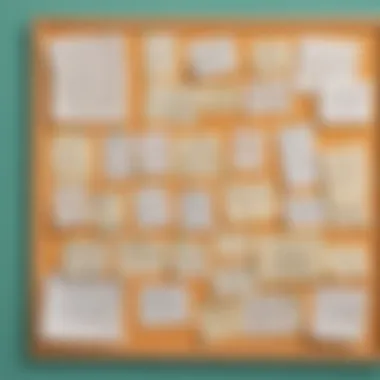

The key characteristic here is its immediacy; these notes can be sent shortly after the event, thus keeping the teacher's efforts fresh in memory. This is a beneficial choice for expressing appreciation. The unique feature is the context; it allows for recognition of specific contributions related to the event. By acknowledging the teacher's involvement in the immediate aftermath, it provides a clearer picture of how their actions impacted the student experience. The downside may be that the note can feel formulaic if not personalized, as the event itself might prompt a standard response.
Consistency in Appreciation
Consistency plays a significant role in expressing thanks. It ensures that appreciation is not limited to specific moments but becomes part of a broader culture of gratitude. Establishing routine times for sending thank you notes can affirm the importance of gratitude.
This approach allows both students and educators to feel valued continuously. Regular expressions of thanks could include notes after major tests or achievements. These consistent acknowledgments foster healthier relationships and create a positive environment. They also help to build a habit of gratitude among students, encouraging them to recognize the contributions of others in their lives. Each note may differ in tone or detail, but together they create a tapestry of affirmations that reinforce the connection between students and their teachers.
Examples of Thank You Notes
In the realm of education, expressing gratitude through thank you notes holds great significance. It provides a way for students and parents to acknowledge the hard work and dedication of teachers. Thoughtful notes enhance the teacher-student relationship, showing appreciation for the impact educators have on their students' lives. As such, the content of these notes can be both reflective and formative, making them essential tools in creating a respectful and caring educational environment.
When considering thank you notes, it is crucial to focus on specific elements such as sincerity, personal touch, and clarity. A well-crafted note reflects genuine appreciation and captures the essence of what a teacher means to a student and their family.
"A simple thank you can make a monumental difference in establishing a positive classroom environment."
Thank You for Academic Support
Teachers play an influential role in a child’s academic journey. A thank you note acknowledging this support is more than just polite; it celebrates the teacher's commitment to student learning. A meaningful note can reinforce a child's love for learning and their appreciation for the guidance received.
Here are some ideas for expressing gratitude for academic support:
- Express Specific Benefits: Mention how a particular lesson or approach made learning easier.
- Share Personal Success: Highlight any achievements that stemmed from the teacher's help, such as improved grades or increased confidence in a subject.
- Offer Encouragement: Acknowledge how their support has inspired a continued passion for the subject.
This type of thank you note may include phrases like:
- "Thank you for helping me understand math better this year. Your explanations made it easier to grasp difficult concepts."
- "I appreciate your dedication to our class. Because of your support, I enjoy reading more than ever!"
Thank You for Personal Guidance
Teachers often provide more than academic help; they also offer personal guidance, shaping the character of their students. Acknowledging this is important, as it shows that teachers care about their students' overall growth. Notes expressing appreciation for this personal touch can strengthen the bond between students and educators and foster a supportive learning atmosphere.
Consider these points when crafting a thank you note for personal guidance:
- Acknowledge the Bond: Mention how the teacher's guidance helped in overcoming personal challenges.
- Reflect on Personal Growth: Share changes you've noticed in yourself because of the teacher’s encouragement.
- Encourage Continued Engagement: Let them know that their influence will extend beyond the classroom.
Possible phrases could be:
- "Thank you for always believing in me, even when I doubted myself. Your support means a lot to me."
- "I appreciate how you take the time to understand your students' needs. It has made a world of difference in my life."
These examples underline the depth of connection and appreciation that can be expressed through thank you notes. They are not merely protocols but gateways to meaningful exchanges that benefit both teachers and students.
Cultural Considerations in Expressing Thanks
Understanding how cultural differences influence expressions of gratitude is vital when crafting thank you notes for teachers. Each culture carries its own unique traditions and expectations regarding appreciation. Recognizing these nuances not only enhances the effectiveness of gratitude expressed but also fosters respect for the diversity within educational settings. This section explores the significance of cultural considerations, focusing on two key aspects: understanding diverse educational backgrounds and respecting cultural norms.
Understanding Diverse Educational Backgrounds
In a multicultural educational environment, students come from varied backgrounds that shape their perspectives on gratitude. Each student's upbringing can inform their views on respect, authority, and appreciation. For example, children from collectivist cultures may emphasize group achievements and communal recognition, while those from individualistic cultures might focus on personal accomplishments. By acknowledging these differences in the context of thank you notes, educators and students can develop a deeper sensitivity towards one another's values.
When crafting a thank you note, it is beneficial to consider the teacher's or the student's cultural background. Including elements that reflect their specific cultural practices can make the message feel more personal and relevant. Here are some suggestions to consider:
- Language Use: If language permits, integrating phrases or salutations in the teacher's native language can express a higher degree of respect.
- Cultural References: Mentioning culturally significant events or achievements can resonate and enhance the bond between student and teacher.
- Expression Style: The directness or indirectness of a thank you note may vary. In some cultures, indirect expressions of gratitude are preferred. Paying attention to these stylistic preferences can improve communication.
Respecting Cultural Norms
Respecting cultural norms is paramount in effectively conveying gratitude. Cultural norms dictate not only how gratitude is expressed but also how it is received. Certain cultures may prioritize formal communication, while others might prefer a more casual approach. Educators must be aware of these differences to avoid misunderstandings.
Recognizing the appropriate context for expressing thanks also involves understanding customs and practices. Some cultures may value public recognition, while others may prefer private expressions of appreciation. Here are a few considerations when respecting cultural norms:
- Public vs. Private Displays: Determine whether a public thank you note, perhaps displayed in class, is welcome or if a private note is more suitable.
- Gift-Giving: In some cultures, gifts accompany thank you notes. Understanding the appropriateness of this can help in creating thoughtful gestures.
- Tone and Formality: Adjust the tone of the note based on cultural expectations. A formal tone may be crucial in some settings, whereas a friendly tone might be more fitting in others.
Recognizing and respecting cultural differences enriches the act of thanking a teacher. It fosters connection and mutual understanding, essential elements of an inclusive education environment.
By taking into account diverse backgrounds and cultural norms, thank you notes become not just gestures of appreciation, but thoughtful communications that strengthen relationships between educators and their students. Such attention to detail elevates the experience of expressing gratitude, encouraging a culture of respect and understanding.
Final Thoughts on Appreciation
In the context of expressing gratitude towards teachers, the concept of appreciation holds significant weight. Appreciation goes beyond mere words; it encapsulates a meaningful recognition of the time, effort, and dedication that educators invest in shaping young minds. As we have explored throughout this article, effective ways to express thanks can enhance the educator-student relationship, fostering a positive and nurturing environment conducive to learning.
When students and parents take the time to articulate their gratitude, it can lead to a profound impact on both the teacher and the student community. Expressing thanks helps teachers feel valued and understood. This recognition can motivate them to continue their hard work and commitment. Teachers often face various challenges in their roles, and a simple thank you can act as a powerful reminder that their efforts are noticed and appreciated.
The Long-term Impact of Gratitude
Gratitude has far-reaching effects that can extend well beyond the immediate moment. When students express gratitude effectively, they cultivate a sense of belonging, not only within the classroom but in the broader school community. This process nurtures emotional intelligence and empathy, both critical life skills for young learners.
Moreover, when gratitude is a consistent practice, it creates an environment where students feel safe to express themselves. This leads to open communication and collaboration, which are essential aspects of a thriving educational atmosphere. Research has shown that gratitude can improve mood and foster resilience, helping both teachers and students navigate the ups and downs of the school year with a more positive outlook.
Encouraging a Culture of Appreciation
Creating a culture of appreciation within schools requires intentional efforts from educators, students, and parents. It involves not just individual thank you notes but comprehensive initiatives that promote recognition and gratitude as core values of the school ethos.
- Lead by Example: Teachers can model appreciative behavior by recognizing students' achievements, no matter how small. This sets the tone that appreciation is a valued aspect of learning.
- Incorporate Gratitude in Lessons: Lessons focusing on the importance of gratitude can help children understand its significance and how to express it appropriately. Activities like creating thank you cards or writing letters can encourage practical application.
- Host Events to Celebrate Teachers: Schools can organize appreciation days dedicated to recognizing the efforts of educators. Occasions such as Teacher Appreciation Week can amplify gratitude expressed through classroom activities and community engagement.
Ultimately, instilling a culture of appreciation not only improves relationships between teachers and students but also enhances the overall school spirit. By embracing gratitude, educational environments can become places where everyone feels acknowledged, encouraged, and inspired to give their best.

